Learn to identify the plants in our Indigenous Plant Garden, and discover their uses. Names are listed in SENĆOŦEN, English, and Latin.
Plant identification
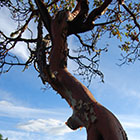
ḰEḰEIȽĆ
Arbutus Arbutus menziesii
The Arbutus tree has been used for a wide variety of things on the NW coast. The WSANEĆ peoples used the bark and leaves medicinally to help treat colds, stomach aches, cramps and even as a post-childbirth contraceptive. The bark can be infused to treat cuts, wounds, sore throats, and help treat diabetes while the inner bark was used to make dresses. Tannin, also found in the bark of Arbutus trees, was used to tan and cure hides.
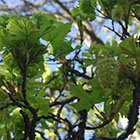
ȾŦÁ,EȽĆ
Big-Leaf Maple Acer macrophyllum
Traditionally, all parts of this tree were used for medicinal, edible, spiritual, and practical purposes. For example, the bark was made into tea to treat tuberculosis, and the maple sap was mixed to treat sore throats. The flowers, shoots and sap are all edible. The leaves were used as containers, and also for covering dishes and adding flavour when cooking. The spiritual and symbolic powers of the tree involve good health and balance. The hard wood was used for canoe paddles, hence the name “Paddle Tree” given by the coastal peoples. The bark was used to make ropes and baskets.
SȻEȾEṈIȽĆ
Bitter cherry tree: Skwt’ theng’ –ilhoh
Bitter cherry bark: T’e ‘lem
Bitter Cherry Prunus emarginata
Many indigenous groups of the southern coast of British Columbia used Bitter Cherry for a myriad of purposes. The Thompson tribe used the bark for twine, dip nets, and to construct fishing weirs. The Nitinaht band used the bark to make wolf whistles for ceremonial use. Medicinal applications include a tea made from the bark that can treat gastro-intestinal problems, tuberculosis and even the common cold. A tea from the bark and leaves has been used as a contraceptive and to control hemorrhaging following childbirth. The tree’s extremely bitter, bright red berries contain small amounts of hydrogen cyanide that can stimulate respiration. Traditionally, a concoction of the roots combined with gooseberry was believed to make children more obedient.
Black Huckleberry or Mountain Huckleberry Vaccinium membranaceum
The Black Huckleberry plant has been a valuable source of nourishment for many First Nations peoples of the North West coast. It was so valuable that the plant was often transplanted if the community moved. The plant contains vitamins that are beneficial for optimal health. A drying technique was used to preserve the large amount of berries they gained in a season. First Nations cultures were spiritually connected to the plant and held great respect for it. It was included in the important “first fruit ceremonies”. According to Nancy Turner the fruit of the plant was considered to be the “chief of berries” and the “great grandmother” of plants.
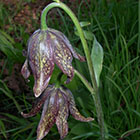
TSÁLIQW
Chocolate Lily Fritillaria affinis
This plant has been an important food source for Coast Salish communities for centuries. The starchy bulblets look like large grains of rice, (the plant is called rice-root in some regions because of this) and were a source of complex carbohydrates. The bulbs were boiled or steamed until they were soft, and then could be eaten whole or mashed into a paste. The unprocessed bulbs could also be dried and stored for winter or traded with other communities.
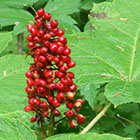
ḰO,PEȽĆ
Devil's Club Oplopanax horridus
This plant has been used widely amongst indigenous communities of British Columbia and southern Alaska for centuries. While its young spring shoots are edible, this plant has been much more useful for a wide variety of medicinal, ceremonial and protective purposes. Topical washes were used to treat skin infections, and decoctions and teas were prescribed for stomach problems, ulcers, arthritis, and post-partum recovery. Applications in contemporary medicine include treating tuberculosis and Type 2 diabetes. Devil’s Club is also considered to have spiritual powers linking the human and Supernatural worlds; according to Earl Claxton, communities on the Saanich peninsula made face paint from the thorns as protection from evil spirits.
False Solomon's Seal Smilacina racemoso
False Solomon’s seal is a plant species in the lily family. While all parts of the plant are edible, the most commonly consumed are the young shoots, roots, and the berries of the plant. The berries are rich in vitamins and are most commonly used cooked or made into jellies due to their bitter taste. The young shoots, which emerge in spring, can be prepared and used similarly to asparagus. The roots can be cooked like potatoes, pickled, or dried and used as a tea to relieve headaches and treat stomach aches and body stiffness. Half a cup of tea made from the leaves and drunk daily for a week is said to prevent conception. A leaf decoction of the plant can be used topically to treat rashes and reduce itching.
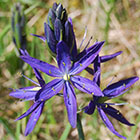
₭ȽO,EL
Great Camas Camassia leichtlinii
Camas was a traditional food for indigenous groups within its natural range. The starchy bulbs were cooked in earth ovens for many hours to convert the inulin to sugar, and were eaten like potatoes or pounded into a flour to add to other dishes. This carbohydrate was an incredibly important trade item for indigenous groups on the southern tip of Vancouver Island, and the camas fields were owned by families and carefully tended to maximize yield. Although the Lekwungen territory, on which the college sits, was once known for its “blue carpet” of camas meadows that are in bloom in the spring, due to restricted access and modern development only 5% of the camas ecosystem is still intact today.
KÁMQIḴSEN
Gummy Gooseberry Ribes lobbii
This plant has been used commonly amid Indigenous people along the west coast of North America, stretching from Vancouver Island down to northern California. Gummy gooseberry was eaten by a few groups of Indigenous tribes. The Kwakwaka'wakw of northern Vancouver Island would eat these berries with eulachon oil at ceremonial feasts and the Coast Salish would make bread and cakes with them. The roots were traditionally used for treatments of diarrhea. By mixing the roots with salt water, this plant was also used for treating mouth and body sores. The thorns were used for removing splinters, prying boils, and for tattooing. When the roots were prepared with cedar and wild rose, they could be woven into rope.
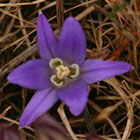
Harvest Brodiaea Brodiaea coronaria
Part of the lily family, the corms of this plant were gathered with wooden digging sticks and eaten by the Wiyot, Atsugewi, Miwok, Yana and other tribes of California. In some regions this plant is commonly referred to as the Indian Potato. The Miwok dug the bulbs in the spring when the shoots were just appearing above the ground and cooked them in earth ovens. The Atsugewi boiled the corms in water and sometimes cooked them in an earth oven.
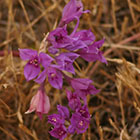
S₭EX̱
Hooker's Onion Allium acuminatum
Members of this genus are very healthy additions to the diet. The sulphur compounds that give them their onion flavour help reduce blood cholesterol levels, and act as a tonic to the digestive and circulatory systems. Straits and Coast Salish groups ate the bulbs raw or steamed them in pits. The Nuu-chah-nulth harvested the bulbs in late summer and steamed them in pits lined with lichens and alder boughs. According to one source, these onions were a remedy for the flatulence that came with eating camas bulbs.
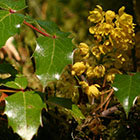
SENI
Berries: SENI
Bush: SENI, IȽĆ
Low Oregon Grape Mahonia nervosa
The Oregon grape has a varied history of use in the W̱SÁNEĆ territory. Direct consumption of the berries and leaves provides digestive benefits. Large quantities of fresh berries have been considered an antidote for shellfish poisoning. A tea, made from the roots, is an effective laxative and blood tonic. The roots can also be dried and processed into dust for external use to treat infections because of its anti-microbial properties. The inner bark, when boiled, is the main ingredient in traditional yellow dye used for basketry and wool.
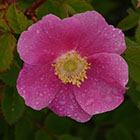
ḴELḴ
Fruit/hips: ;ḴELḴ
Bush: ḴELḴ IȽĆ
Nootka Rose Rosa nuktana
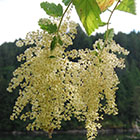
KÁȾEȽĆ
Ocean Spray Holodiscus dicolor
ȽWE, ḴIM
Berry: ȽWE, ḴIM
Bush: ȽEW,ḴIMIȽĆ
Oval Leaf Blueberry Vaccinium ovalofolium
This perennial shrub, which has its greatest bloom in mid spring, can grow up to 8 feet tall. This plant has proved to be a valuable resource for indigenous communities residing on the West Coast of North America, spanning from Alaska to Oregon. These plants flourish in moist regions, particularly coniferous forests and along shaded stream banks, and therefore thrive in British Columbia’s coastal climate. The leaves, bark, and berries of this plant are edible, and provide a variety of benefits. Common medicinal uses for the plant include the treatment of urinary tract infections, lung infections, and expulsion of parasites, such as ringworm. The oval leaf blueberry also contributes to the material culture of indigenous peoples.
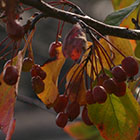
ḴÁ,E.W̱IȽĆ
Tree: ḴÁ,E.W̱IȽĆ
Fruit: ḴÁ,EW̱
Pacific Crabapple Malus fusca
The fruit of this tree is an important food source for many coastal people. In late summer and early autumn, clusters of the green, tart fruit are harvested. Due to its high acidity, the fruit easily stores for the winter without any processing, although the fruit is often made into jam. The hard wood of the tree has been used to make tools, such as axe handles, halibut hooks, bows, and fishing floats. The bark is has been used medicinally to treat kidney problems, colds and tuberculosis. The bark is also thought to be good for the appetite and is used to increase the appetite of someone who is ill. However, the bark contains cyanide-producing compounds, so one must use caution when ingesting it. Always consult with an expert before using it for medicinal purposes.
Pacific Dogwood Cornus nuttallii
This deciduous, flowering tree has been used for many purposes by indigenous communities from the west coast of British Columbia to California. The wood was used to make harpoons, bow, arrows, combs, and needle hooks. The Cowichan people on Vancouver Island made knitting needles from the Pacific Dogwood. The Straits Salish used the bark to make dark brown or red dye. The bark was also used medicinally to treat skin infections, fevers, digestive issues, to purify the blood to strengthen the lungs, and as an antiseptic. In 1956 the Pacific Dogwood was adopted as British Columbia’s floral emblem.
ȾIWEK
Berry: ȾIWEK
Bush: ȾIWEK, IȽĆ
Red Elderberry Sambucus racemosa
This plant is very rich in Vitamin C. Although any part of this plant can be eaten, it is recommended to cook the berries first before ingestion and to use caution, since all parts of this plant (including uncooked berries) contain poisonous glycosides that can cause nausea, vomiting, and diarrhea. When prepared and administered properly, the bark and leaves can be used to treat many different illnesses like: toothaches, colds, sore throat, fever, cuts, sores, sprains, bruises, and arthritis. The blossoms are known to be used for treatment of measles, and are also edible. The fruit, stems and bark can all be processed to make a dye.
DAḴE
Berries: DAḴE
Bush: DAḴE IȽĆ
Salal Gaultheria shallon
Salal is a perennial evergreen shrub native to the Pacific Northwest. Salal is full of vitamins and antioxidants that prevent degeneration and promote good health. Traditionally, Indigenous people the length of the Northwest coast ate the berries fresh or dried them in cakes for later consumption. The plant’s leaves can be prepared in a tea or tincture to treat coughs, heartburn, bladder inflammation, stomach or duodenal ulcers, and menstrual cramps. The leaves have astringent properties, making them useful to treat wounds. The Quileute people chewed the leaves and applied them to burns and sores to soothe the skin.

ELILE
Berry: ELILE
Bush: ELILE IȽĆ
Edible sprouts: ŦÁ,ŦKI
Salmonberry Rubus spectabilis
The Salmonberry can be found anywhere from Southern Alaska to California, scattered throughout areas of the Coast and Cascade mountains. The berries are the only edible part of the plant, as the leaves and roots are mildly toxic if ingested. Eaten fresh or fried, the berries are a good source of Vitamin C and fibre. The leaves were used for a variety of medicinal purposes. Boiled into a tea, they were used to treat diarrhea and dysentery and to stimulate appetite, while a poultice made from chewed leaves was applied to burns. Infusions were also used to treat anemia and long menstrual pain. Indigenous groups on the central BC coast pounded the bark from salmonberry trigs into a pulp that was used to dull toothaches and treat skin infections.
PEPKIYOS
Berries: PEPKIYOS
Bush: PEPKIYOS IȽĆ
Snowberry Symphoricarpos albus
The snowberry has many medicinal uses such as relieving muscle and stomach pain (however the isoquinoline alkaloid chelidonine found in the berries induces vomiting, diarrhoea and dizziness if ingested in large quantities). Depending on how it was prepared, the snowberry was used to remove warts, soothe eyesores, heal cuts and burns and treat tuberculosis. The roots and stems were used as a cure for urinary infections and venereal diseases. The saponin in the berries makes them useful as a soap to wash ones hair. Various southern Vancouver Island elders indicate that the plant can be used to brush off after being near a grave yard by putting the leaves or the berries into water and washing your face in it.
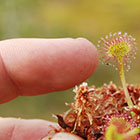
Sundew Drosera rotundifolia
The roots, flowers and fruit-like capsules of the sundew are prepared as a tea and used for a wide variety of medicinal purposes. The plant’s antispasmodic properties make it effective medicine for cough relief, and cross culturally it has been used for dry coughs, whooping coughs, bronchitis, bronchial cramps, and asthma. When prepared as a poultice it can also be applied to sunburns and toothaches.
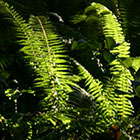
SŦXÁLEM
Sword Fern Polystichum munitum
The fronds and the rhizomes of Sword Fern have been used for a wide variety of purposes. Both can be cooked or steamed, peeled and eaten, although the rhizomes were considered a starvation food because of their undesirable taste. The fronds are used to line earth ovens, as bedding, and as mats on house floors. Medicinally, the Nuu-chah-nulth people used the fern to cure diarrhea. Lummi women used it to hasten childbirth. Various groups used it to ease a sore throat and tonsillitis.
The Sword Fern also has recreational uses. Some coastal peoples such as the Squamish and Ditidaht used the fern to play a game called “Pala Pala”. This game was played by pulling off the leaflets of the fern one by one while saying “Pala” meaning “One” while holding their breath. This game could be played by children but was also used to as a training tool for young men so they could dive down in the ocean to harvest bull kelp.
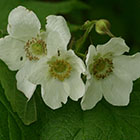
DEḰEṈ
Berries: DEḰEṈ
Bush: DEḰEN IȽĆ
Edible sprouts: ŦȺ,ŦKI
Thimbleberry Rubus parviflorus
Thimbleberries are commonly found throughout the province. A wide variety of indigenous groups processed the berries into cakes to store for the winter months. Thimbleberry is a potent source of vitamin C, which helps ward off intestinal problems like dysentery. The sprouts were peeled and eaten raw in the spring before they became woody. The leaves were used medicinally in a number of ways. They could be rubbed on the skin to help with acne or irritation; the Cowlitz of Washington would crush the leaves to soothe burns. In Wsanec territory, the dried leaves were ingested or made into a tea to alleviate diarrhea; elsewhere they were reportedly ingested to treat nausea and vomiting.
ḰEYÁ,LEŚIȽĆ
Trembling Aspen Populus tremuloides
Twinflower Linnaea borealis
Twinflower has been used as a food source by the Carrier Indians of British Columbia’s interior. Indigenous tribes including the Montagnais, Tanana, Algonquin, Iroquois and Snohomish Indians have all used twinflower for a variety of medicinal purposes. It has been used as a tonic during pregnancy as well as a treatment for painful menstruation. When mashed up, the plant can be used as a poultice for inflamed limbs and as a remedy to relieve painful headaches. A decoction of leaves can treat colds, while a decoction of the twigs can be given to children to relieve fever, cramps and crying.
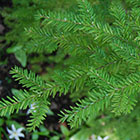
ȾḴI, EȽĆ
Western Hemlock Tsuga heterophylla
Western Hemlock wood was used for a wide variety of tools, from spoons and harpoon shafts, to dip net poles and fire tongs. The bark has a very high tannin content, and was used for as a tanning agent, pigment, and cleaning solution. Many indigenous communities pounded and boiled bark in fresh water to make dyes for Mountain goat wool and basket materials. The strong smelling, sticky pitch was used as a cement to patch canoes and water containers. It was also used as a salve for healing wounds, to prevent chapping and to remove vermin from hair. The bark can be used as a laxative, a wash for sore eyes or skin sores, to stop hemorrhages and bleeding, to treat syphilis and tuberculosis, and to soothe a sore throat. The inner bark was also eaten fresh, or processed into cakes and sometimes mixed with berries.
Western Red Cedar Thuja plicata
Northwest coast indigenous communities used giant cedar trunks for their canoes, housing materials, tools, and totem poles. The bark was used for everything from rope and basketry to clothing and baby diapers. The low smoke, aromatic fire from red cedar was favored for smoking salmon.
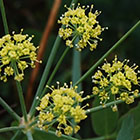
KEXMIN
Wild Celery Lomatium nudicaule
The dried seeds of the plant can be boiled into a tea to assist with sore throats, coughs and other bronchial ailments. The seeds may also be chewed, plant fibre discarded, to achieve the same effect. The inhaled smoke of the burning seeds as medicine is said to treat headaches, as is the inhaled aroma of compressed seeds or seeds added to a poultice and placed on the forehead.
When burned as medicine, KEXMIN seeds provide both a cleansing and protection from negativity, and harmful spirits.
The Washoe people of Nevada use the root of this plant to make tea to treat bronchial ailments. It is of note that not one Washoe person who had access to this plant died during the Spanish flu pandemic of 1918, while other tribes in Nevada suffered losses.
ḴÁMQ
Berries: ḴÁMQ
Bush: ḴÁMQ IȽĆ
Wild Gooseberry Ribes divaricatum
The berries, roots and leaves of this plant are all edible. The berries were often mixed with salal berries and boiled down to make cakes that could be stored for winter. The roots can be boiled and used to help relief cramps by rubbing onto the affected area. Newborn babies were bathed in boiled leaves by their grandparents so that they would grow up to be intelligent and obedient. The roots were also boiled with cedar rose roots and woven into rope and fishing weirs. On Haida Gwaii the sharp thorns were used for tattooing. Tattooing was a rite of passage, and in Haida society children were tattooed by their maternal aunties.
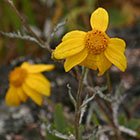
Woolly Sunflower Eriophyllum lanatum
The woolly sunflower is found along coastal regions from British Columbia to California. The Chehalis people of British Columbia and Washington were said to mix the dried flowers with grease to make a strong love potion. In traditional Miwok tribes of California, the leaves of woolly sunflower were made into a poultice and put on parts of the body to relieve pain and heal wounds. In Washington, the Skagit people were known to rub the leaves on themselves to prevent dry skin.
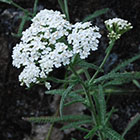
ṮELIḰ EȽP
Yarrow Achillea millefolium
Yarrow is one of the most widely used medicinal plants, both locally and worldwide. In BC, this plant has been used by many indigenous nations, including the Thompson River Salish, Ulkatcho First Nation, Nuxalk Nation, and the Tsimshian people. It is used to treat many ailments, from colds, venereal diseases, and bladder ailments to infusions for bathing arthritic limbs, and poultices for sciatica, sore muscles, and breast abscesses. Chewed leaves can be applied to burns and boils, and made into a chest rub for bronchial infections. Vancouver Island ingenious peoples reportedly used yarrow to stop bleeding and was often taken on hunting trips for this reason. Yarrow was also used during child birth to help with the birthing of the placenta and any hemorrhaging. Other traditional uses include treating fever, deep cuts, and as a digestive aid.
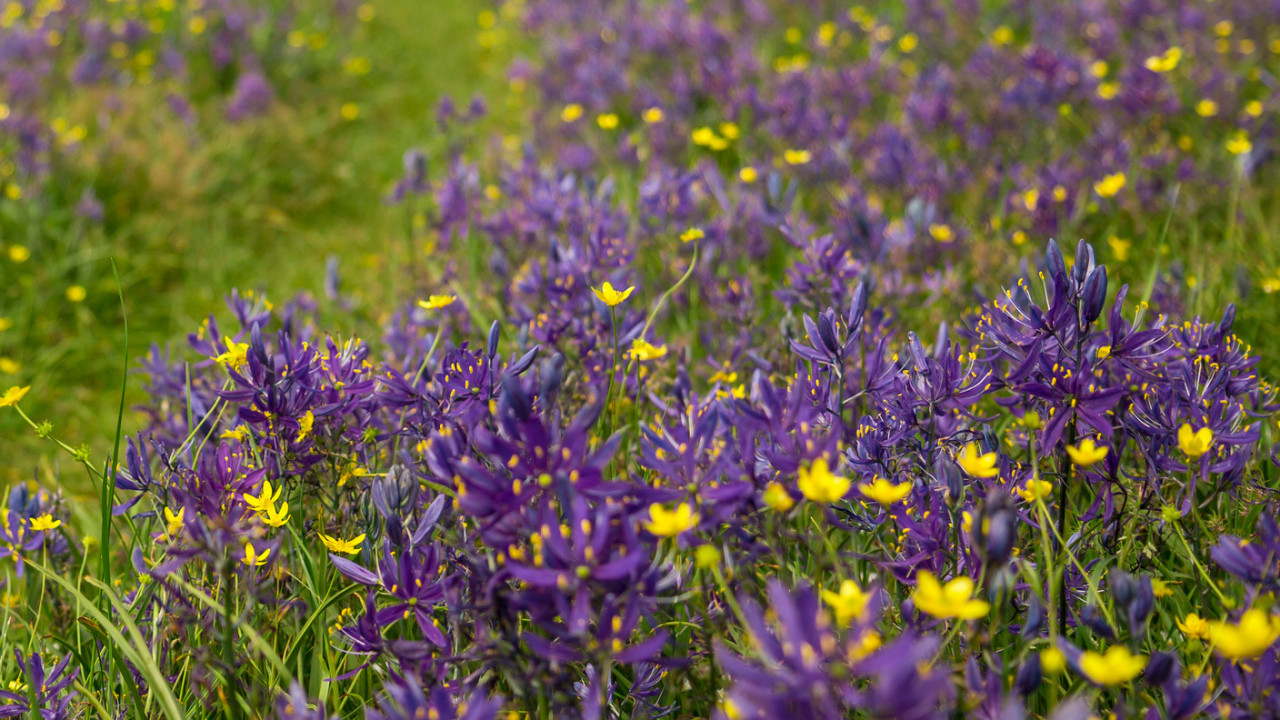
Get involved
You can help Camosun become more sustainable. There are lots of ways to participate, both on campus and off.